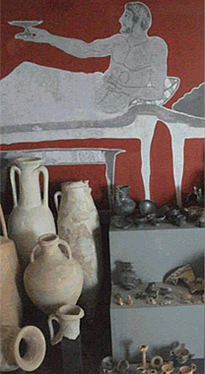
|

The Greek Jaitas
flourished on the plateau of Mount Jato, inside an ancient settlement
which origins are commonly believed to date back to the Sicanian-Elymian
peoples of western Sicily (1000 BC). Even if it is contested or refused,
the first historical source comes from Thucydides who mentions the
occupation of the city by the Spartan general Gylippus during his
journey towards Syracuse. It is mentioned again in 340 BC, in relation
to an ambush laid by the Carthaginian to the mercenary soldiers of
Euthymius of Leucas.
The most flourished period is recognized to be around 300 BC, when the relation between the native inhabitants of Monte Jato and the Greek peoples consolidated; some of the newcomers even decided to move in the Valley, giving life to a profitable model of cohabitation. The Romans will come after the Greeks, enumerating it among the "stipendiarius" cities of Sicily. In 71 BC Jaitas suffered from the persecution and robbery of Gaius Verres, the Sicilian governor of the time. After the roman domination a certain Byzantine influence is asserted, even if it is not documented; it was terminated by the Arab conquest of Sicily that started in 827 AD. The Norman sources and documents claim that the Muslim presence in Giato (the name of the city during the Arab-Norman era) was very strong. During that period, the city was populated by 13,000 Muslim families. During the Norman domination Giato (Catù) experienced an incredible economical welfare, as it is asserted by the words of Ibn Idrisi in his "Book of Roger" and by the famous Latin-Arab document of 1182 called Rollo, thanks to which William II donated to S. Maria Nuova of Monreale the territories of Jato (Magna Divisa Jati), Corleone and Calatrasi. Finally, the Swabian domination has left a negative mark on the Muslim city bringing it firstly to rebellion (1243) and then to defeat (1246) by the hand of the Emperor Frederick II. |



